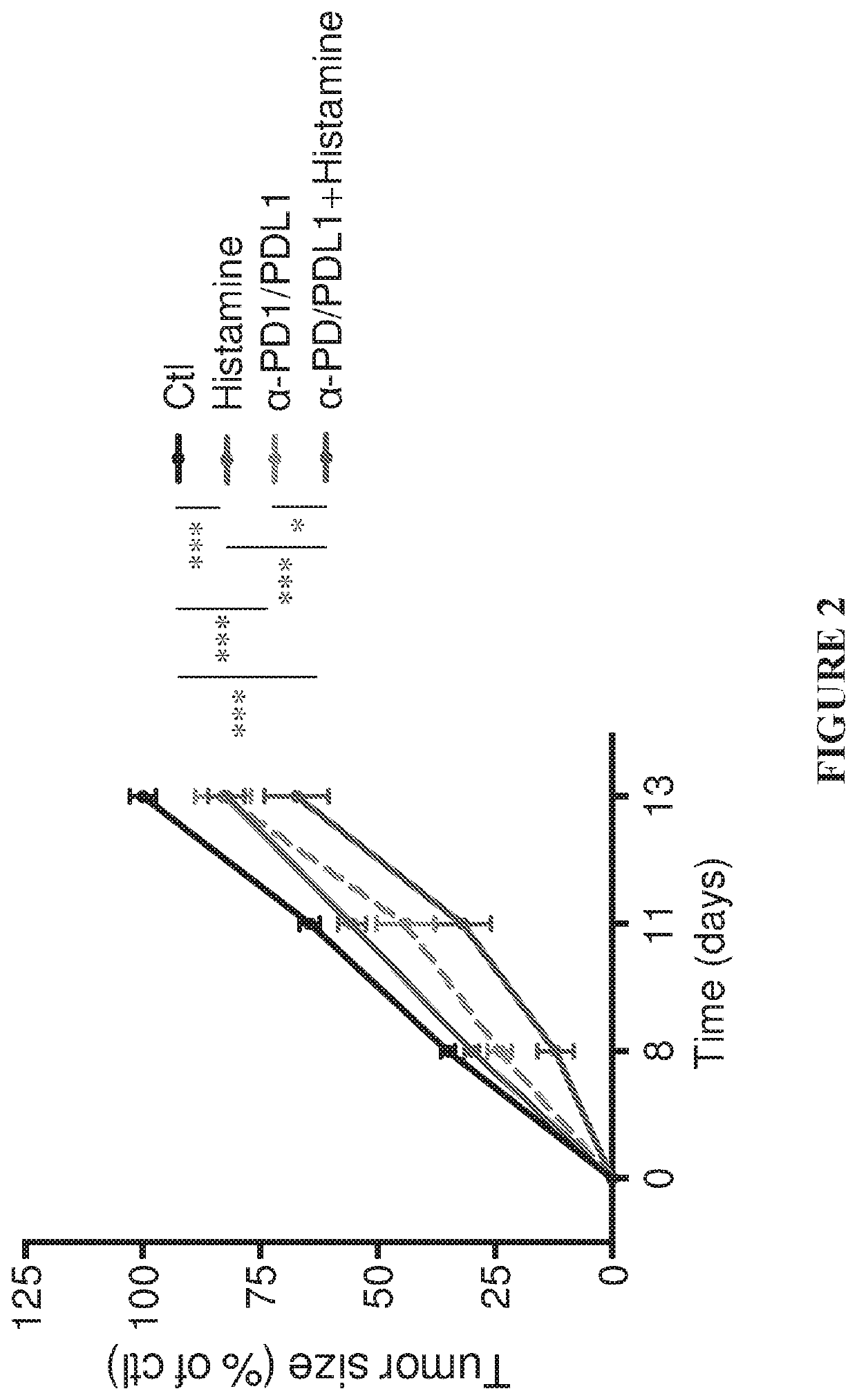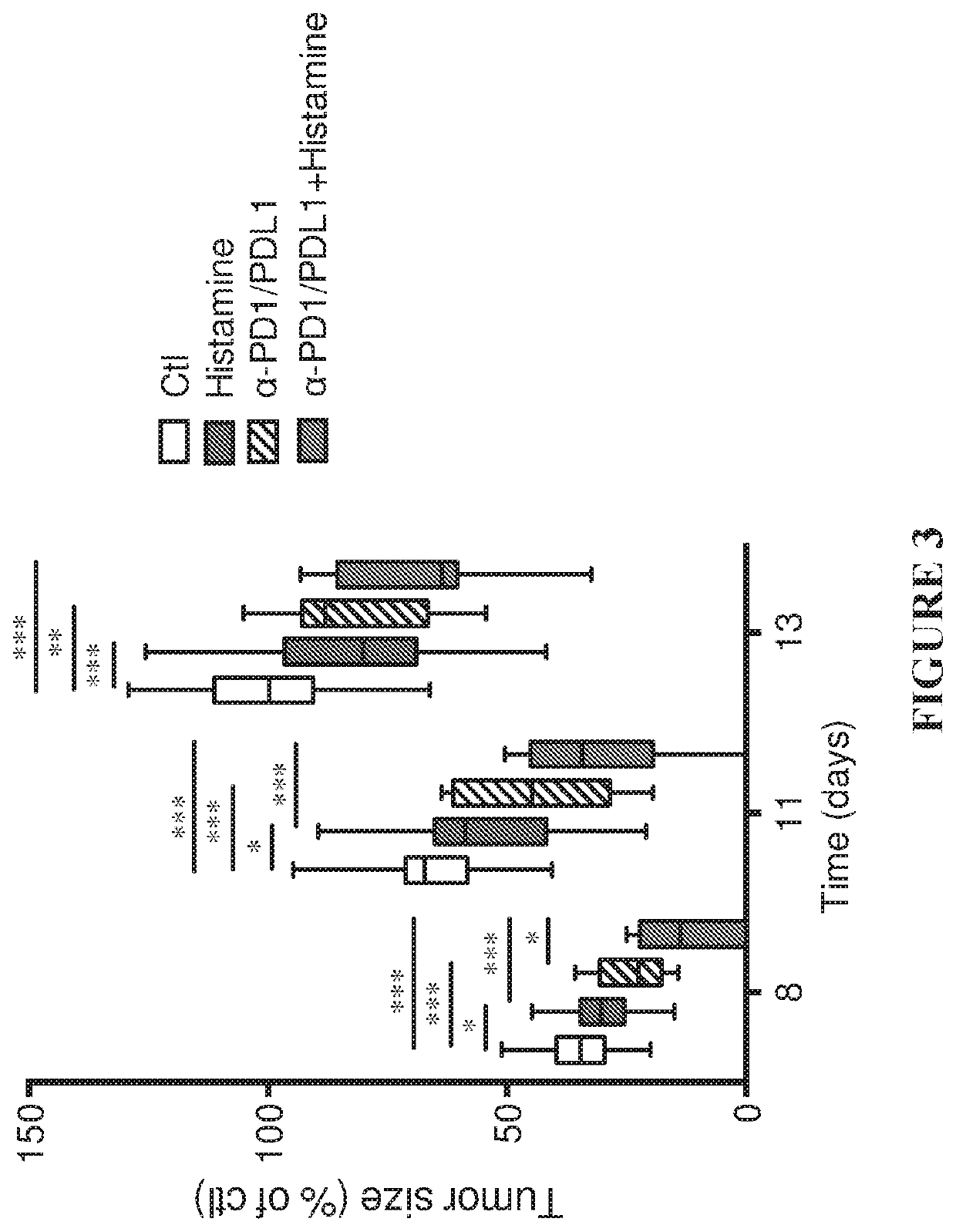Histamine dihydrochloride combinations and uses thereof
a technology of histamine dihydrochloride and combinations, applied in the field of histamine dihydrochloride combinations, can solve the problems of poor long-term survival prospects after relapse of aml, less effective killing of tumor cells, and often unoptimized cancer treatment. achieve the effect of reducing tumor burden and tumor burden
- Summary
- Abstract
- Description
- Claims
- Application Information
AI Technical Summary
Benefits of technology
Problems solved by technology
Method used
Image
Examples
example 1
Combination of Anti-PD-1 / Anti-PDL1 and Histamine—Methods
[0150]The EL-4 thymoma cell line (provided by Dr. Ingo Schmitz, Otto-von-Guericke-University, Magdeburg, Germany) was cultured in DMEM medium (Sigma, Stockholm, Sweden) supplemented with 10% fetal calf serum, 100 U / ml penicillin, 100 μg / ml streptomycin and 2 mM L-glutamine, as described in Martner, A. et al. The Journal of Immunology, volume 194, no. 10, pp. 5014-5021. C57BL / 6J mice (6-8 weeks old, purchased from Charles River Laboratories, Sulzfeld, Germany) were inoculated subcutaneously with 1.75-2×105 EL-4 tumor cells and treated with saline (control) or 1.5 mg histamine dihydrochloride (purchased from Sigma-Aldrich, Stockholm, Sweden) diluted in saline, by intraperitoneal injections three times per week starting one day before inoculation of cells. Two-hundred forty μg of an antibody against the programmed cell death-1 receptor (anti-mouse PD1, clone RMP1-14, referred to as a-PD1) and 240 μg of an antibody against the prog...
example 2
Combination of Anti-PD-1 / Anti-PDL1 and Histamine—Results
[0151]In agreement with a previous study (Martner, A. et al. The Journal of Immunology, volume 194, no. 10, pp. 5014-5021), treatment of EL-4-bearing mice with histamine significantly reduced tumor growth rate (FIGS. 1-3). The administration of α-PD1-+α-PDL1-inhibitory antibodies resulted in a comparable reduction of tumor growth. The combination of histamine and anti-PD1 / anti-PDL1 increased the reduction of EL-4 tumor growth over each treatment (histamine or α-PD1 / α-PDL1) alone. In FIGS. 1-3, tumor size is indicated as % of control, where 100% was the mean size of control tumors at the end of the experiments (i.e. at 2 weeks after tumor inoculation).
example 3
Dynamics of Cytotoxic T Cell Subsets During Immunotherapy Predicts Outcome in Acute Myeloid Leukemia
Materials and Methods
Patients, Study Design and Objectives
[0152]This single-armed multicenter phase IV study (Re:Mission, NCT01347996, registered at www.clinicaltrials.gov) enrolled 84 patients (age 18-79) with AML in first CR. As outlined schematically in FIG. 4, the patients received ten consecutive 21-day cycles of histamine dihydrochloride (HDC; Ceplene) in combination with low-dose IL-2 during 18 months or until relapse or death.
[0153]The treatment continued for a total of 18 months or until the patients relapsed, died, discontinued therapy because of adverse events, withdrew consent, or became lost to follow-up. Cycles 1 to 3 comprised 3 weeks of treatment and 3 weeks off treatment, and in cycles 4 to 10 the off-treatment periods were extended to 6 weeks. In each cycle, patients in the treatment arm received HDC (Maxim Pharmaceuticals, San Diego, Calif.) at 0.5 mg subcutaneous t...
PUM
| Property | Measurement | Unit |
|---|---|---|
| size | aaaaa | aaaaa |
| size | aaaaa | aaaaa |
| time | aaaaa | aaaaa |
Abstract
Description
Claims
Application Information
 Login to View More
Login to View More - R&D
- Intellectual Property
- Life Sciences
- Materials
- Tech Scout
- Unparalleled Data Quality
- Higher Quality Content
- 60% Fewer Hallucinations
Browse by: Latest US Patents, China's latest patents, Technical Efficacy Thesaurus, Application Domain, Technology Topic, Popular Technical Reports.
© 2025 PatSnap. All rights reserved.Legal|Privacy policy|Modern Slavery Act Transparency Statement|Sitemap|About US| Contact US: help@patsnap.com



